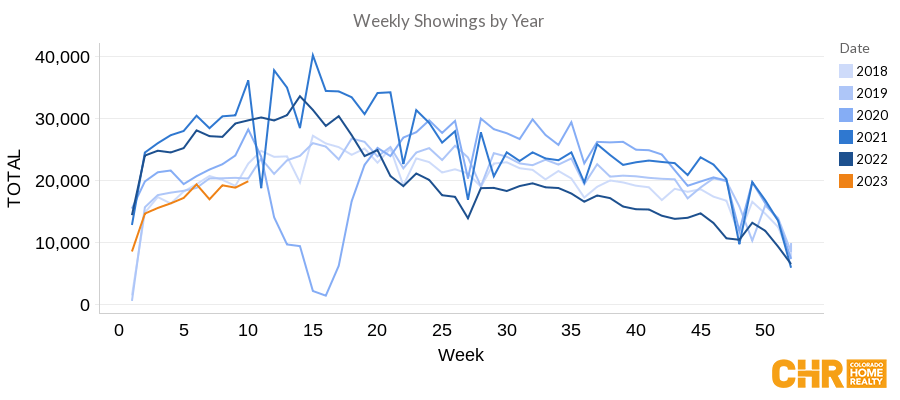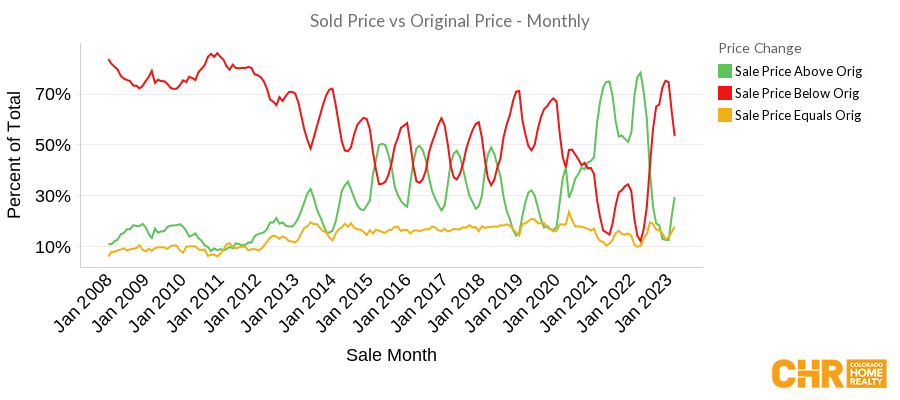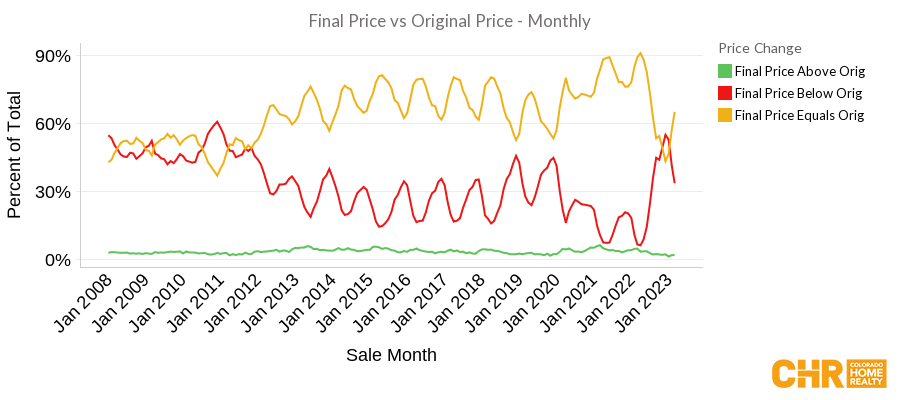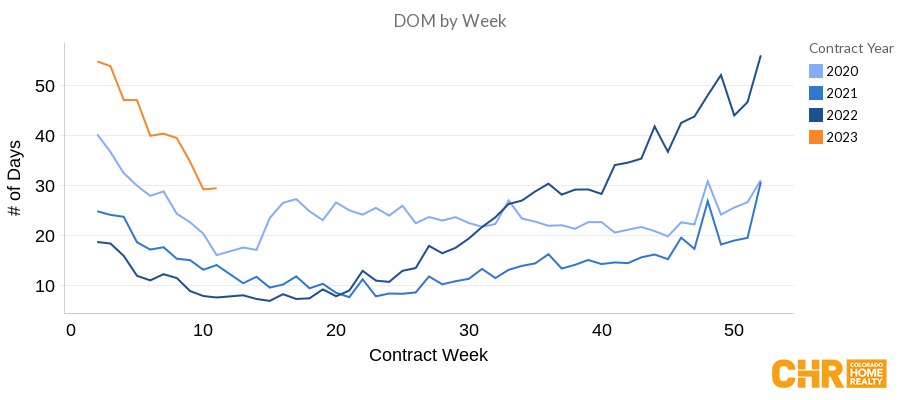The New Real Estate Market
March 16, 2023 | Market Trends
March 16, 2023 | Market Trends
The real estate market is just, different. Prices are rising, but not as fast. Buyer activity is strong, but there just aren’t as many buyers. Inventory is steadily increasing, and marketing time for homes is down from the beginning of the year.
The current market stability is a testament to the resilience of Colorado real estate. This resilience is due to market forces like a stable population and the strength and diversification of the Colorado economy.
In the face of recent bank failures (more on that later), volatile mortgage interest rates, dubious reports about inflation, monetary policy, labor markets and economy, and the craziness of today’s geopolitical environment, Colorado real estate remains, steady.
That’s the word. Steady. And the fundamentals are strong.
Back again are the days of buying and selling real estate driven by what used to matter. Changes in a person or family’s life. Choosing to live differently because of the birth of children, marriage, job, graduations, getting a dog (or cat), retirement, the passing of family members and so many variations of these things.
Gone are the days of buying real estate to make a quick buck.
For now at least, supply and demand.
Nationwide, over 70% of all outstanding mortgages have an interest rate less than 4% and 90% of all mortgages are less than 5%. This translates to very attractive mortgage payments for many American homeowners. Even if tough economic times arrive, these mortgage holders will be committed to keeping their home and low payment, more than any time in history.
This will keep inventory low.
And, in the face of interest rate fluctuation as low as 5.5% and as high as 7.25% in just the last 6 weeks, buyer activity remains resilient. At just under 20,000 home showings across the Denver market per week each of the last 4 weeks, buyer activity has been similar to the 2018 and 2019 markets.

While the adjustment from 2.5% to 7% mortgage rates a year ago was hard, a 1-2% mortgage rate fluctuation appears to be more palatable for today’s more pliable buyer.
The combination of these two factors; sellers slow to market and buyer resilience, is creating the most stable and modestly appreciating real estate market we’ve seen in a very long time.
More homes are beginning to sell for over the asking price as the Spring market heats up. As interest rates rose in the spring of 2022, we saw buyers go into hibernation. As this happened, prices softened, homes sat on the market and buyers were able to be more aggressive with their offers.
In April of 2022 we saw more than 78% of all homes sell for more than the asking price. By December of 2022, more than 75% of all homes were selling for under the asking price.
We are beginning to see the trend reserve yet again with 29% of properties selling for more than the asking price. As the market continues to heat up, we expect this number to rise.

Fewer sellers are reducing the asking price. only 34% of sellers reduced the price of their home before going under contract, compared to a high of 55% in December of 2022.

And the number of days a home sits on the market before receiving a contract has come down substantially since the beginning of the year. Starting 2023, the average seller was on the market almost 2 months before receiving an offer on their property.
As of this article writing, we sit at a healthy average of 29 days on market. This number too is expected to continue a modest decline through the Spring market.

It’s a wild ride right now. The stock market, jobs market, inflation and monetary policy are all guessing games at the moment. Friday of last week, the second largest bank in the history of the United States with over $200 billion in assets, failed. On Sunday, federal authorities took over a second bank and Monday a third. The initial reaction was reasonable concern of a cascading effect, worldwide. The US treasury stepped in to protect depositors (right or wrong) and that seems to have shored up confidence in the banking system, for now. Though we are watching the European markets carefully.
The United States household savings rate is as low as it has been in a very long time and credit card debt is the highest ever. And the US government continues to push spending and debt to new heights.
All of these and other macro-economic forces are reason for every American to pause and ponder the right and best course of action with respect to any investment, including real estate.
Our advice, live your life but do so prudently, strategically, but not out of fear. Have money in reserve, spend less than you make, invest wisely and don’t make any large, long-term purchases without reasonable job security.
We believe for many reasons that real estate continues to be one of the best investments and asset classes available. Of course we would say that, right? Across America since 1941, home values have increased 73 years, declined 7, and been exactly flat one time. We believe Denver is stronger than the rest of the country.
Many people have expressed interest, but uncertainty, about investing in real estate. For many, now would seem like a ridiculous time to be buying real estate, right? But wise investments are often made when everyone else is operating in fear.
We have many stories like this. One story we told just last week; an early 50’s friend of ours who started investing in real estate just 6 years ago. He is now retiring from his day job, has millions in assets and produces over $40,000 per month in revenue and $20,000 per month in net income. And, he and his family are able to take advantage of real estate investment tax benefits virtually eliminating his taxes.
In our upcoming class on April 19, we teach our friends and family about the fundamentals of investing in real estate and the wildly powerful tax advantages that most people, including many CPAs, don’t understand.
If you are intrigued, sign up, or reach out to me and I’ll get you on the list for the future.
Stay nimble. Live your life. Be positive about Colorado real estate. But be aware of the larger United States economic conditions. And keep some capital in reserve.
The Colorado economy is strong and diverse but still impacted by monetary policy and broader economic conditions. If you want to buy, sell or invest in real estate, let’s sit to discuss the wisdom and strategies you might deploy to best meet your goals.
Interest rates are likely coming down for a host of reasons. As rates drop, more buyers will enter the market and that demand will cause prices to rise. Those who purchase now will likely get the benefit of purchasing at a lower price and be able to refinance in 6 months if rates are lower. Those who are selling this spring will experience the benefit of a faster moving, more seller friendly market.
Share this Post